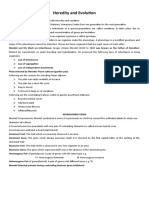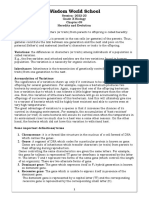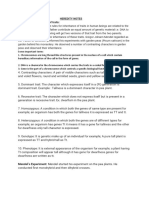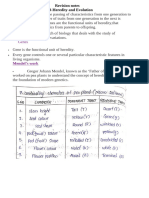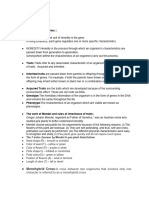Genetic A
Genetic A
Uploaded by
preet patelCopyright:
Available Formats
Genetic A
Genetic A
Uploaded by
preet patelCopyright
Available Formats
Share this document
Did you find this document useful?
Is this content inappropriate?
Copyright:
Available Formats
Genetic A
Genetic A
Uploaded by
preet patelCopyright:
Available Formats
STUDY OF TRANSFER OF CHARACTER FROM ONE GEN TO THE OTHER (OR FROM THE PARENT OF THE
OFFSPRING) = GENETICS
CHARACTER IS AN INHERITABLE FEATURE
TRAITS IS A FORMS OF A CHARACTER: - FOR EXAMPLE, HEIGHT IS A CHARACTER SHORT IS A TRAIT
AND LONG IS ALSO A TRAIT =
GENE IS CHARACTER
ALLELES IS TRAIT
AUTOSOMES ARE RESPONSIBLE FOR THE PHYSICAL OF CHARACTERS
THE SEX CHROMOSOME DETERMINES THE SEX OF An INDIVIDUAL
THE FIRST 22 PAIRS ARE HOMOLOGOUS
THE 23RD PAIR IS HETEROLOGOUS
DOMINANT: - the one which expresses itself morphologically over the other allele
RECESSIVE: - the allele that does not express itself morphologically and is suppressed in the presence
of the dominant allele
The same allele is known as homozygous
Diff allele is known as heterozygous
Monohybrid when only one character is studied
Dihybrid when we study the transfer of 2 characters
Mendel is the father of genetics
He used pea in his experiments
He gave two laws in monohybrid: - dominance and segregation
He gave a law in dihybrid: - law of independent assortment
Monohybrid: -
Genotype is genetic makeup (1:2:1)
Phenotype is physicals appearance 1:3
Dihybrid
Phenotype – 9:3:3:1
Genotype – very complex
Autosomal – body character
Son gets it because of his mother and father gets it because of his daughter
google notes hai yeh sab |
The term genetics was proposed by William Bateson.
➢ Genetics is the branch of biology that deals with the study of inheritance and variation of
characters from parent to offspring.
➢ The kind of transmission of characters from parent to offspring’s called heredity or
inheritance. Likewise, no two individuals of a species are alike such differences are called
variations.
➢ Monohybrid Cross is the inheritance of one pair of contrasting characters. For example, a
cross between a pea plant with a dominant green seed and one with a recessive yellow seed.
➢ Dihybrid Cross is the inheritance of two pairs of contrasting characters. For example, the
inheritance of the yellow and round seed characters and the green wrinkled character is a
dihybrid cross.
➢ Gene: Mendel presumed that a character is determined by a pair of factors present in each
cell of an individual. These are known as genes in modern genetics.
➢ Allele or allelomorph They are various forms of a gene or Mendelian factor which occur on the
same locus on homologous chromosomes and control the same character. Alleles or
allelomorphs control different expressions or traits of the same character
➢ Heterozygous: An individual having two contrasting Mendelian factors or genes for a
character. HA heterozygote or heterozygous individual is also called hybrid. E.g., Tt.
➢ Homozygous: An individual having identical Mendelian factors or genes for a character (TT or
tt). Homozygous or homozygote individual is always pure for the trait.
➢ Dominant Factor: An allele or Mendelian factor which expresses itself in the hybrid
(heterozygote) as well as in the homozygous state. It is denoted by a capital letter (T for tallness)
➢ Recessive Factor: An allele or Mendelian factor which is unable to express itself in the hybrid
in the presence of an alternate (dominant) allele. It is denoted by a small letter (t for dwarfness).
The recessive factor expresses itself only in the homozygous state (e.g., tt ).
➢ Mutation is a new sudden inheritable discontinuous variatthathich appears in the organism
due to the permanent change of its genotype.
OR
➢ Sudden changes in one or more genes in the progeny, which normally may not have existed in
the parents, grandparents, or even great-grandparents are called mutations. For Example
albinism, and sickle cell Anaemia.
➢ Mutation may be of gene mutation – changes in the DNA & chromosomal mutation –
changes in the number of arrangement of the chromosome.
➢ Variaton : The differences among the members of the same species and offspring of the
same parents are referred to as variation.
OR
➢ Variation is the departure from a complete similarity between individuals of the same species.
➢ Genotype: It is the gene complement or genetic constitution of an individual about one or
more characters irrespective of whether the genes are expressed or not. For example, the
genotype of the hybrid tall pea plant is Tt, pure tall, TT, and dwarf tt.
➢ Phenotype : The observable, morphological or physiological expression of an individual with
reagard more characters is called phenotype. For the recessive gene, the phenotype is similar to
genotype. The or dominant genes, the phenotypic expression can be due to its homozygous
genotype or heterozygous genotype. For example, the Phenotypic tall pea plant can be
genotypically TT or Tt.
LAWS AND PUNNET SQAURES
➢ G. J. Mendel ( 1822-1884 ), the father of genetics, was an Austrian monk.
➢ He was the 1st scientist who made a systematic study of Patterns of inheritance of
characters from parents to progeny.
➢ He carried out breeding experiments on garden pea plants (Pisum sativum) and formulated
basic laws of heredity.
➢ Mendel crossed a pure tall garden Pea plant and a pure dwarf Pea plant, the resulting
offspring were called F1 generation.
➢ Why Mendel Selected pea plant for his experiments?
(i) Garden pea has distinct, easily detectable contrasting traits
(ii) The plant reproduces well & grows to maturity in a simple season.
(iii) The Pea plant is self-pollinating in nature because pea flower is bisexual.
(iv) Self pollination could be prevented by removing the male reproductive parts of the flower.
(v) Cross-pollination could be done artificially.
➢ Law of Paired Factor : A character is represented in an individual ( diploid ) by atleast two
factors. The two factors lies on the two homologous chromosomes at the same locus. They may
represent the same ( homozygous, e.g., TT in case of pure tall pea plant, tt in case of dwarf pea
plant ) or alternate expression ( heterozygous e.g., Tt in case of hybrid tall pea plant ) of the same
character.
➢Law of Dominance : In a hybrid where both the contrasting alleles or unit factors are present,
only one unit factor / allele called dominant is able to express itself while the other factor / allele
called recessive remains suppressed In a cross between pure breeding red flower ( RR ) Pea
plant and white flower ( rr ) Pea plant, the F1 generation is red flowered though it has received
both the factors ( R and r ). It is because of the dominant nature of factor for red flower colour
and recessive nature of the factor for white flower colour. On self breeding, the recessive trait
reappear in the F2 generation showing that it is suppressed in F1 generation and not lost.
➢Law of Segregation : Law of segregation states that the two contrasting factors do not mix in
the F1 generation but segregate or separate from each other at the time of gamete formation.
➢Mendel continued his experiments further and allowed self pollination in F1 hybrids. The
resultant offsprings were called F2 generation. In F2 generation tall and dwarf plants are formed
in 3 : 1 ratio. So that each gamete receive only one factor, either dominant or recessive. Hence
gametes are pure. Thus law of segregation is also referred to as law of purity of gametes.
➢ Law of independent assortment states that the factors of different pairs of contrasting
characters behave independent to each other at the time of gamete formation, and at the time of
fertilization they bring about all the possible combinations of characters.
➢ Mendel crossed a pure yellow, round seeded garden pea plant with a pure green, wrinkled
seeded garden pea plant. All F1 individuals show yellow, round characters. In F1 dihybrids yellow
character is dominant over green character and round character is dominant over wrinkled
character.
➢ Mendel allowed self-pollination of F1 dihybrids and observed F2 generation. In F2 generation,
he find yellow round; yellow wrinkled; green round; green wrinkled pea plants in 9 : 3 : 3 : 1 ratio.
In the above cross, in F2 generation, two more new varieties of pea plants are formed besides
the parents. They are yellow, wrinkled and green, round plants.
Know the Terms
➢ Character : It is well defined morphological or physiological feature of an organism. eg. Stem
height.
➢ Gene symbol : Each character is provided with a symbol. eg. T for tallness and t for dwarfness.
➢ Gene locus : A particular region of the chromosome representing a single gene is called gene
locus.
➢ Hybrid : The heterozygous organism produced after crossing two genetically different
individuals is called a hybrid .
➢ Pure line : It is a strain of true breeding individuals which have homozygous traits due to
continued self breeding over the generations.
➢ Genome : It is a complete set of chromosomes where every gene and chromosome is
represented singly as in a gamete.
➢ Gene pool: The aggregate of all the genes and their alleles present in a interbreeding
population is known as a gene pool.
➢ Backcross: It is a cross between hybrid and one of its parents in order to increase the number
of traits of that parent.
➢ Test cross : It is cross between an individual with a dominant trait and a recessive organism in
order to know whether the dominant trait is homozygous or heterozygous.
You might also like
- Tooth Damage in Captive Orcas (Orcinus Orca)Document10 pagesTooth Damage in Captive Orcas (Orcinus Orca)Jeffrey Ventre MD DC0% (1)
- NCLEX RN Practice Questions Set 1Document6 pagesNCLEX RN Practice Questions Set 1Jack SheperdNo ratings yet
- HydroceleDocument38 pagesHydroceleAlfie Yannur100% (2)
- Mendelism and Deviation Form Mendel's FindingsDocument43 pagesMendelism and Deviation Form Mendel's FindingsNewsonNo ratings yet
- Class 10 - Heredity and EvolutionDocument14 pagesClass 10 - Heredity and Evolutionamir anwarNo ratings yet
- Grade 10 Biology - Notes - CH 9-HeridityDocument6 pagesGrade 10 Biology - Notes - CH 9-HeridityitsmeadiparasharNo ratings yet
- CHP 5 - Principles of Inheritance and VariationDocument68 pagesCHP 5 - Principles of Inheritance and VariationAbhishek ratnoo100% (1)
- Genetics NotesDocument6 pagesGenetics NotesTRIANGULAR CLASSNo ratings yet
- Heredity and EvolutionDocument13 pagesHeredity and EvolutionManish Defence Training AcademyNo ratings yet
- Class 10 HeredityDocument7 pagesClass 10 HeredityInsiya HuzefaNo ratings yet
- Biology Lesson Note For SS3 Second TermDocument43 pagesBiology Lesson Note For SS3 Second TermOjoNo ratings yet
- Genetic Inheritance and Genetic InteractionDocument40 pagesGenetic Inheritance and Genetic InteractionKiran KurhadeNo ratings yet
- CL 12 Bio Chapter-5 Principle of Inheritance and VariationDocument53 pagesCL 12 Bio Chapter-5 Principle of Inheritance and Variationjackieaj093No ratings yet
- Genetics A LevelDocument39 pagesGenetics A Levelbarasasamuel922No ratings yet
- 10 Heredity NotesDocument7 pages10 Heredity Notes07akul.sharma07No ratings yet
- Principles of Inheritance and VariationDocument12 pagesPrinciples of Inheritance and VariationBiju Mylachal100% (1)
- Notes of HERIDITY2020Document5 pagesNotes of HERIDITY2020Shubham VermaNo ratings yet
- Heredity NOTESDocument7 pagesHeredity NOTESaayanahmed8dNo ratings yet
- Inheritance and VariationDocument14 pagesInheritance and Variationthirukarthick2709No ratings yet
- Topic: Heredity and Evolution - : Subject:Biology CLASS:10Document18 pagesTopic: Heredity and Evolution - : Subject:Biology CLASS:10sara park100% (1)
- Heredity and EvolutionDocument15 pagesHeredity and Evolutionrvharshini31No ratings yet
- Principles of Inheritance and VariationDocument9 pagesPrinciples of Inheritance and Variationaadusharma828No ratings yet
- Unit 1 ADocument58 pagesUnit 1 ANishant MishraNo ratings yet
- Heredity NotesDocument10 pagesHeredity NotesKanishka ChauhanNo ratings yet
- Principles of Inheritance and Variation (Class-12) - 1Document9 pagesPrinciples of Inheritance and Variation (Class-12) - 1Ashok Kumar100% (1)
- Heredity NotesDocument6 pagesHeredity Notesbaldevsingh1235151No ratings yet
- Biology of HeredityDocument5 pagesBiology of Hereditypalmer okiemuteNo ratings yet
- 7 Woz 9 C BPXLSMPF 0 Co 507Document17 pages7 Woz 9 C BPXLSMPF 0 Co 507Venu GopalNo ratings yet
- Heredity NotesDocument5 pagesHeredity Notesprasathishu156No ratings yet
- Chapter 3 Genetics IBDocument37 pagesChapter 3 Genetics IBSanaa SamkoNo ratings yet
- Patterns of InheritanceDocument100 pagesPatterns of InheritanceGianne DitablanNo ratings yet
- GeneticsA LevelDocument38 pagesGeneticsA Levelezraariho01No ratings yet
- Genetics and HeredityDocument12 pagesGenetics and HeredityhafsaNo ratings yet
- CBSE Class 10 Science Notes Chapter 9 Heredity and EvolutionDocument18 pagesCBSE Class 10 Science Notes Chapter 9 Heredity and EvolutionHarsh AgarwalNo ratings yet
- Genetics UpdatedDocument23 pagesGenetics UpdatedmalladikiranvarmaNo ratings yet
- Genetics and Heredity BiologyDocument7 pagesGenetics and Heredity BiologyMUDASIR REHMANNo ratings yet
- Geneticso LevelDocument25 pagesGeneticso Levelrobertoryema4No ratings yet
- Principles of Inheritance and VariationDocument7 pagesPrinciples of Inheritance and VariationAfzal MohammedNo ratings yet
- Introduction To Genetics and Dna & RnaDocument53 pagesIntroduction To Genetics and Dna & Rnamonzer elsamadonyNo ratings yet
- Heredity NotesDocument6 pagesHeredity NotesShri GaneshNo ratings yet
- Chapter 22 InheritanceDocument121 pagesChapter 22 Inheritancebhskardu83100% (2)
- LESSON PLAN Introduction To HeredityDocument20 pagesLESSON PLAN Introduction To HeredityAnshika AggarwalNo ratings yet
- CBSE Class 10 Science Notes Chapter 9 Heredity and EvolutionDocument20 pagesCBSE Class 10 Science Notes Chapter 9 Heredity and Evolutiondrphysics256No ratings yet
- CH 8-Heredity and EvolutionDocument9 pagesCH 8-Heredity and EvolutionRam VaidNo ratings yet
- Velammal Bodhi Campus, Ponneri Velammal Iit/Neet Academy: Class: Xii Sub: Biology Book Back QuestionsDocument10 pagesVelammal Bodhi Campus, Ponneri Velammal Iit/Neet Academy: Class: Xii Sub: Biology Book Back QuestionsKaviya NNo ratings yet
- Physics ProjectDocument8 pagesPhysics ProjectAanya SachdevaNo ratings yet
- Mendel's Law of Inheritance 24Document10 pagesMendel's Law of Inheritance 24darktomal920No ratings yet
- RightyDocument13 pagesRightyshahsisters03.15No ratings yet
- 2nd Term Biology Ss3Document20 pages2nd Term Biology Ss3Wisdom Lawal (Wizywise)No ratings yet
- 3.inheritance and VariationDocument16 pages3.inheritance and VariationbishriempireNo ratings yet
- Definition of Gene (Repaired)Document107 pagesDefinition of Gene (Repaired)Ananda PreethiNo ratings yet
- Chapter 4Document3 pagesChapter 4shubhamrkv123No ratings yet
- Mendalian Laws of InheritanceDocument8 pagesMendalian Laws of InheritanceSharifullah KhanNo ratings yet
- Genetics: Inheritance Refers To The Process by Which Characters/traits Are Passed FromDocument55 pagesGenetics: Inheritance Refers To The Process by Which Characters/traits Are Passed FromTop gadgets and moviesNo ratings yet
- Heredity DefinitionDocument7 pagesHeredity DefinitionArianz GamingNo ratings yet
- GENETIC INHERITANCE+pedigree AnalysisDocument110 pagesGENETIC INHERITANCE+pedigree AnalysisGeorge Olson100% (1)
- Genetics - Summary NotesDocument10 pagesGenetics - Summary NotesIzy GomezNo ratings yet
- Heredity and Evolution Class 10 Notes CBSE Science Chapter 9 PDFDocument11 pagesHeredity and Evolution Class 10 Notes CBSE Science Chapter 9 PDFvanshNo ratings yet
- Elegant Planner Cover DesignDocument41 pagesElegant Planner Cover Designharibharathan007No ratings yet
- Chapter 3. Principles of Genetics - IntroductionDocument22 pagesChapter 3. Principles of Genetics - IntroductionankurbiologyNo ratings yet
- Everyday Errors in Checkers Play-BackgammonDocument203 pagesEveryday Errors in Checkers Play-BackgammonApostolopoulos Spyros100% (1)
- Parrish October 14Document9 pagesParrish October 14Lakhan AgrawalNo ratings yet
- Joy Special Mock For STD Seven English MediumDocument20 pagesJoy Special Mock For STD Seven English MediumGodfrey TeshaNo ratings yet
- 11 Foods That Lower CholesterolDocument5 pages11 Foods That Lower CholesterolsleshiNo ratings yet
- Pregnancy Complication - HypertensionDocument37 pagesPregnancy Complication - HypertensionJess PeltraNo ratings yet
- 4Document130 pages4Upender BhatiNo ratings yet
- TUGAS AKHIR BLOK 14 Management of Japanese Encephalitis (19.25-19.31Document14 pagesTUGAS AKHIR BLOK 14 Management of Japanese Encephalitis (19.25-19.31Rizky Pramata Simamora 19000029No ratings yet
- Edible Oils Packaging (Regulation) Order, 1998Document14 pagesEdible Oils Packaging (Regulation) Order, 1998Syed Ali Akbar BokhariNo ratings yet
- Leffler 2017Document23 pagesLeffler 2017Dominic AmuzuNo ratings yet
- Social Aspect of Health & DiseasesDocument19 pagesSocial Aspect of Health & DiseasesDr. Rakshit SolankiNo ratings yet
- The WandererDocument17 pagesThe WandererFelipe Figueiredo100% (5)
- Symptoms of Black Magic & Roqya As A Protection. - FacebookDocument11 pagesSymptoms of Black Magic & Roqya As A Protection. - Facebookrohan23783No ratings yet
- Summative Test EAPP DIALDocument4 pagesSummative Test EAPP DIALJhun PegardsNo ratings yet
- MucostaDocument3 pagesMucostaJessica DensingNo ratings yet
- Alchemy of FoodDocument4 pagesAlchemy of FoodprasujnairNo ratings yet
- Baby Vaccination Price List & Schedule Chart in India - Indian Beauty HubDocument2 pagesBaby Vaccination Price List & Schedule Chart in India - Indian Beauty HubsareenckNo ratings yet
- Upper Gastrointestinal Bleeding Ugb Causes and Treatment 2475 3181 1000153Document3 pagesUpper Gastrointestinal Bleeding Ugb Causes and Treatment 2475 3181 1000153Envhy AmaliaNo ratings yet
- Selectivebreedingpowerpoint 130416182435 Phpapp01Document18 pagesSelectivebreedingpowerpoint 130416182435 Phpapp01priarun18No ratings yet
- Enterobius GregoriiDocument4 pagesEnterobius GregoriiMike zombieNo ratings yet
- Chola MS PreAuth FormDocument5 pagesChola MS PreAuth FormvijayclaimbuddyNo ratings yet
- Pregnancy in Dental TreatmentDocument62 pagesPregnancy in Dental TreatmentChinar HawramyNo ratings yet
- Nutrition ScienceDocument42 pagesNutrition Sciencecazaam AbdullahiNo ratings yet
- Cataract SurgeryDocument9 pagesCataract SurgerygandikotavtpsNo ratings yet
- Dendritic Cell Therapy PDFDocument12 pagesDendritic Cell Therapy PDFგიორგი ანთაძეNo ratings yet
- Pphi SindhDocument3 pagesPphi Sindhxam.rajperNo ratings yet
- Astrology and The Scientific MethodDocument26 pagesAstrology and The Scientific MethodBobby Morin100% (2)
- 3 Congenital Megalourethra Prenatal Diagnosis and Postnatalautopsy Findings in 10 Cases PDFDocument6 pages3 Congenital Megalourethra Prenatal Diagnosis and Postnatalautopsy Findings in 10 Cases PDFDirga Rasyidin LNo ratings yet
















